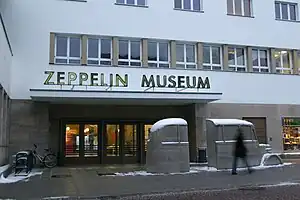| Friedrichshafen World War II bombings | |||||
|---|---|---|---|---|---|
| Part of Strategic bombing campaign in Europe | |||||
 Zeppelin Museum Friedrichshafen | |||||
| |||||
| Belligerents | |||||
|
|
(Defence of the Reich) | ||||
| Commanders and leaders | |||||
|
Carl Spaatz Arthur Harris | |||||
The German city of Friedrichshafen was bombed during World War II as part of the Allied strategic bombing campaign against German war materiel industry, particularly in the targeting of German fighter aircraft production and long range missile development.
Background
Friedrichshafen lies in the Bodenseekreis district, on Lake Constance in the extreme south of Germany, and at the time it was at the edge of the German nightfighter defences. Targets included the Dornier Flugzeugwerke aircraft works at Manzell, the Maybach tank engine factory, the Luftschiffbau Zeppelin aircraft works and its Oberraderach test facility near Raderach, and the Zahnradfabrik Friedrichshafen (literally "gearwheel factory Friedrichshafen") tank gearbox factory.
In February 1944 an underground factory at Immenstaad near Friedrichshafen was suspected to be a synthetic oil and/or liquid oxygen plant.[1][2] Near Überlingen,[2] forced labor of KZ-Häftlinge im Goldbacher Stollen,[2] KZ Nebenlager Raderach[3] and the Aufkirch subcamp of Dachau concentration camp was used for constructing an underground facility for armament manufacturing (code name "Magnesit"[2]) safe from Allied air raids.
Attacks
| Date | Target | Notes |
|---|---|---|
| 1942-08-17 | Zeppelin Works | Allied intelligence had suspected the Zeppelin Works (German: Luftschiffbau Zeppelin GmbH) was involved with the V-2 rocket.[4] |
| 1943-06-20 | Zeppelin Works | |
| 27/28 April 1944 | ZF Friedrichshafen | |
| 1944-07-20 | Zeppelin Works | |
| 1944-07-28 | Dornier Flugzeugwerke | |
| 1944-08-03 | Oberraderach & ZF Friedrichshafen | |
| 1944-08-16 | Oberraderach | |
| 1945-02-25 | Maybach tank factory | |
References
- Notes
- ↑ "Minutes of Meeting No. 45/6" (PDF). Enemy Oil Intelligence Committee. February 6, 1945. Archived from the original (pdf: document starts – p 19) on 2008-08-21. Retrieved 2009-03-22.
- 1 2 3 4 http://www.stollen-ueberlingen.de/lng/england.htm (Google translation)
- ↑ "KZ Nebenlager Raderach" (in German). V2Werk-Oberraderach.com. Retrieved 2010-12-27. (Google translation)
- ↑ Ordway, Frederick I III; Sharpe, Mitchell R (1979). The Rocket Team. Apogee Books Space Series 36. New York: Thomas Y. Crowell. p. 74. ISBN 1-894959-00-0.
- ↑ "Campaign Diary June 1943". Royal Air Force Bomber Command 60th Anniversary. UK Crown. Archived from the original on 2007-07-06. Retrieved 2009-03-22.
- ↑ Irving, David (1964). The Mare's Nest. London: William Kimber and Co. pp. 65, 81.
- 1 2 Neufeld, Michael J. (1995). The Rocket and the Reich: Peenemünde and the Coming of the Ballistic Missile Era. New York: The Free Press. p. 143, 174,193. ISBN 978-0-02-922895-1.
- ↑ "Campaign Diary April 1944". Royal Air Force Bomber Command 60th Anniversary. UK Crown. Archived from the original on 2007-07-06. Retrieved 27 December 2010.
- ↑ "485th Missions". 485th Bomb Group Association. Archived from the original on 2011-07-24. Retrieved 2010-12-27.
- ↑ "August 1944". 461st Bombardment Group (H). Retrieved 2010-12-27.
- ↑ Glantzberg, Hughes. "Missions". 461st Bomb Group (H) "The LibeRaiders". 461st.org. Retrieved 2009-10-16.
- ↑ Speer, Albert (1970). Inside the Third Reich. Translated by Richard; Clara Winston. New York and Toronto: Macmillan. p. 433. ISBN 978-0-684-82949-4. LCCN 70119132.
- ↑ McKillop, Jack. "Combat Chronology of the USAAF". Archived from the original on 2007-06-10. Retrieved 2007-05-25. February 1945 Archived 2013-09-29 at the Wayback Machine
- ↑ Williamson, Charles C.; Hughes, Richard D.; Cabell, C. P.; Nazarro, J. J.; Bender, F. P.; Crigglesworth, W. J. (5 March 1944). "Plan for Completion of Combined Bomber Offensive".
{{cite journal}}: Cite journal requires|journal=(help)
- Bibliography